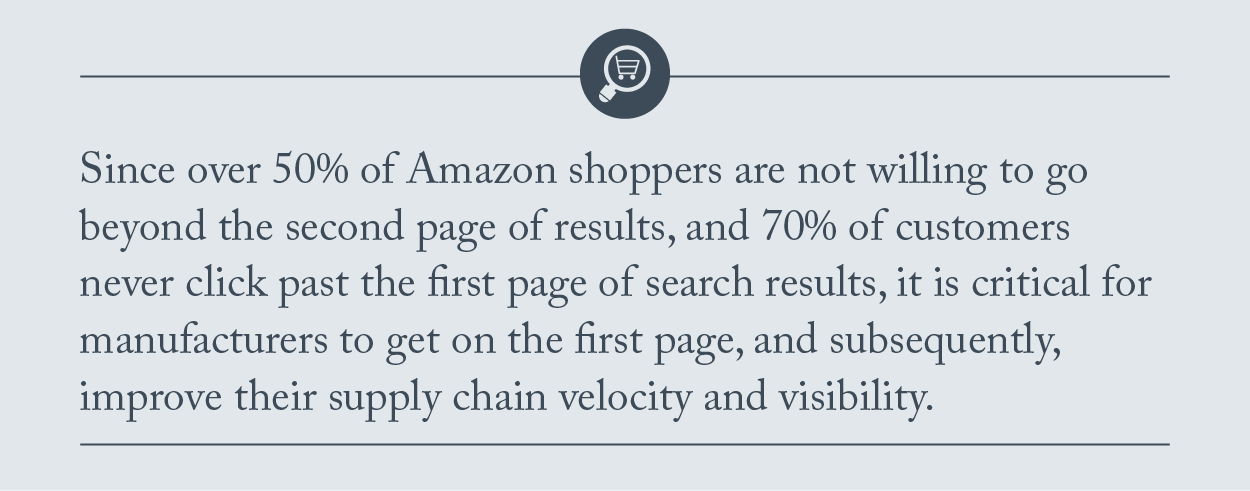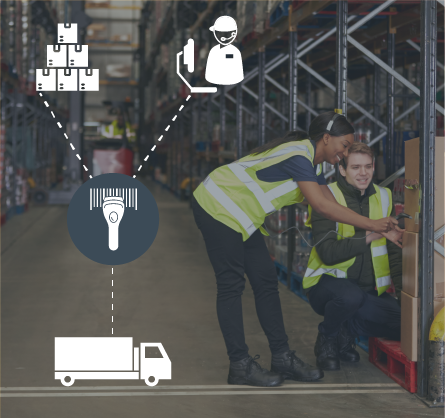Consumers have become accustomed to ordering nearly any product or service online, and the growth of e-commerce continues to impact all markets. In 2018, consumers spent $517.36 billion online with US merchants – up 14.2% from 2017. Now more than ever, organizations are focusing on optimizing and improving their logistics strategy to meet consumers’ growing expectations for same-day or even next-hour delivery.
 Amazon accounts for 40% of US online retail sales, and with the rest of the industry chasing the e-commerce giant, the supply chain is experiencing rapid technological changes. Today, many manufacturers rely on Amazon-type services to sell their goods, and all businesses are looking for ways to innovate their supply chains to meet the requirements for e-commerce logistics. As larger players like Walmart transition away from brick-and-mortar locations to keep pace with the rise in e-commerce sales, it becomes even more critical for organizations to adapt to the evolving landscape.
Amazon accounts for 40% of US online retail sales, and with the rest of the industry chasing the e-commerce giant, the supply chain is experiencing rapid technological changes. Today, many manufacturers rely on Amazon-type services to sell their goods, and all businesses are looking for ways to innovate their supply chains to meet the requirements for e-commerce logistics. As larger players like Walmart transition away from brick-and-mortar locations to keep pace with the rise in e-commerce sales, it becomes even more critical for organizations to adapt to the evolving landscape.
Whether you are looking to meet supply chain visibility or velocity demands, automate processes or invest in new technologies, today’s logistics environment requires your organization to continuously embrace change. Below are crucial areas to consider when adapting in the modern supply chain:
The Evolution of Supply Chain Velocity and Visibility
With Amazon driving digital transformation, other businesses are feeling the push for greater supply chain velocity and visibility. In order to meet the expectations of two-day, one-day, or same-day shipping, organizations must build in an extreme amount of visibility in the supply chain. It is critical for suppliers to know where an order is from the time it is placed to the time it is received by the customer.

Amazon has become a powerful storefront, with manufacturers paying Amazon to include their goods and services on its website. Still, products are often shipped out of a different warehouse than Amazon, like a 3PL warehouse. For vendors looking to receive a better ranking in Amazon product searches, manufacturers must commit to a certain level of visibility and shipping velocity to meet same-day or next-day shipping criteria. Since over 50% of Amazon shoppers are not willing to go beyond the second page of results, and 70% of customers never click past the first page of search results, it is critical for manufacturers to get on the first page, and subsequently, improve their supply chain velocity and visibility.

How quickly a box gets scanned into the UPS or FedEx system is integral to meeting these velocity and visibility requirements. In the digital supply chain, lots of suppliers, 3PLs, and shippers are now putting in as many scans as possible to have visibility into where products are throughout the supply chain and secure placement on the first few pages of Amazon. Digital connectivity tools like radio frequency and radio frequency identification are used to efficiently scan items, and these technologies have become critically important to Amazon, the end customer, the supplier, and 3PLs to provide the necessary visibility into the supply chain.
As a result, Amazon is constantly watching time to induction, or time of first scan, to see if a vendor goes beyond a certain window of time. In the event a supplier exceeds that pre-determined window, the business will lose its Seller Fulfilled Prime badge from Amazon. This can happen in as little as one day, but it frequently takes four to six weeks for a vendor to be verified again. When a manufacturer loses its Prime designation, they can see a 40-50% reduction in sales nearly immediately, according to the Amazon Terms and Conditions.
The Growth of Automation
Consumers are continuing to demand faster delivery. For example, people now expect to order groceries online and have them delivered to their doorstep in the same day. With the window from the time an order is placed to the time a package is delivered continuing to shrink, supply chains are pressed to innovate. The need for speed to fulfill orders is driving the increased adoption of automation to meet the growing pressure on logistics. In fact, ABI Research projects over four million commercial robots will be installed in over 50,000 warehouses by 2025, up from just under 4,000 robotic warehouses in 2018.

While there used to be a fear that robotics would take away human jobs, that apprehension has subsided, as automation is used to augment existing positions. Robotics and automation are taking over repetitive, boring tasks, freeing up people to perform functions that require more skill. With unemployment at record lows, the job market is challenging for employers, so more robotics and technology are being integrated as a result.
Increased Strategic Investment in Technology

In the past, technology used to be a very expensive investment. To be worthwhile, an organization needed to produce a high volume to see any ROI. Ten years ago, technology investments were considered monuments since systems were not flexible to changes in business processes or needs.
Today, technology is more cost-effective and flexible than ever before. Now, many automation system startups exist across the country, and 3PLs are investing in either full- or semi-automation of processes. 3PLs are also helping to develop application and pilot projects. It is becoming more common for 3PLs to develop strategic partnerships with robotics and automation startups early on. These companies are offering 3PLs their technology at a reduced cost or even free of charge so they can test the solutions in a live environment.
To keep pace with the growth and demanding requirements of e-commerce, it is critical for your supply chain to adapt to new technologies. Whether it is increasing visibility, meeting the demands of ever-shrinking delivery times, or bridging the talent gap with automation, organizations have to stay agile in order to remain competitive. Working with a forward-thinking 3PL that is piloting cutting-edge technologies can help your business evolve strategically.
